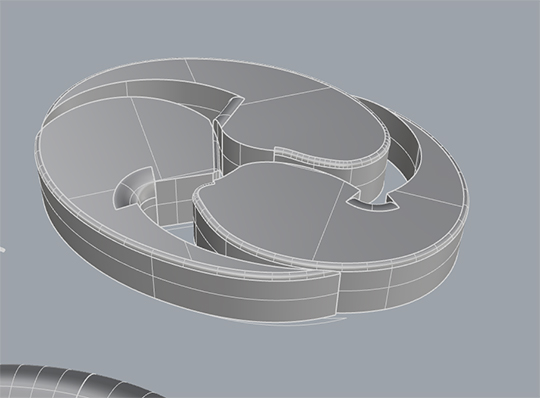Studio 12
Algorithmic Form: Public Happiness
Alessandro Bava and Alexei Haddad

This studio is available to students enrolled in ABPL90142 Studio C, ABPL90143 Studio D, and ABPL90115 Studio E.
Studio Description
The studio will question what urban and architectural form a public infrastructure for wellness and leisure should take; an Antipodean obsession and export coagulating strong cultural communities and aesthetics.
Architecture is the abstract discipline of measuring and seeing the world (in Vitruvius's words, "the reification of reasoning"), and as such concerned with organising data, proportions, and harmony. It is the political art of giving spatial definition to lebensformen; of building and giving material form to ways of living individually and collectively. Lastly, it is the management of complex material and productive flows, including the labour implicated in the making of the human habitat. Moving within this definition we will explore analog and algorithmic tools to devise a new formal, compositional and tectonic vocabulary to deal with emerging urban problems related to public welfare.
The studio's methodology is founded on cultural research, typological analysis and formal experimentation weaving a continuity between the tradition of Rationalism and new innovations in computational design.
Studio Outcomes
The project's methodology will be focusing on precise composition, 3d modelling, spatial analysis and tectonic experimentation, grounding formal explorations within established methodologies and historical knowledge. Formal research is developed with sensibility to existing urban typologies and context; the use of new computational tools is to be measured within proportional rules and compositional rigour, and contempered to deep cultural research on the context and programmatic brief.
The deliverables will be split into two phases.
Phase one; each student will develop a high quality critical visual research book on the topics of body practises, wellness, and sport.
Phase two; students will produce an architectural project for large-scale public wellness infrastructure sited in rural Australia.
Learning outcomes: to produce an architectural methodology for tectonic experimentation based on precise composition, 3d modelling, spatial analysis. Beyond this, the development of computation and experimental software to support design experimentation.
Studio Leaders
Alessandro Bava (b.1988 Naples, Italy) is an architect based in Milan. Currently he runs BB a collaborative architectural practice with Fabrizio Ballabio. After graduating from the Architectural Association in London with Pier Vittorio Aureli he was part of ayr, a collective making research on the sharing economy and domesticity and was the editor of Ecocore, an ecology magazine. He has taught a cluster on computational architecture at Bartlett B-Pro and is currently curating the next issue of the program's academic Journal 'Prospectives'. His work has been exhibited at the Venice Biennale, the Berlin Biennale, the Stedelijk Museum in Amsterdam, the Ludwig Museum in Cologne, Fondation Cartier in Paris, Moderna Museet in Stockholm and recently at the Quadriennale in Rome.
Alexei Haddad (b.1991) is an Australian architect based in Milan. He directs usa, an architecture and research office based in Milan with projects in the EU, United Kingdom and Australia. He has worked in professional practice across the EU and Australia. Some of these projects include scenography, retail, public works, housing, exhibition design for Fondazione Prada, KaDeWe, MUBI, GR10K, Triennale di Milano and E-Flux. Beyond professional practice he has participated as a studio leader for the last two year at the University of Melbourne, and in varying roles as a critic, researcher and speaker at University of Tongji, ETH Zurich, Fondazione Prada, the University of Melbourne, the University of Technology Sydney, TU Graz, NABA Milan and IUAV Venice.
Readings & References
- Alessandro Bava, Computational Tendencies, eflux architecture, 2020
- Alessandro Bava Rhythm is a Floor Plan, Spike Art Magazine #66
- Pier Vittorio Aureli, Less is Enough: On Architecture and Asceticism, Strelka Press, 2013 Matteo Pasquinelli, Three Thousand Years of Algorithmic Rituals: The Emergence of Al from the Computation of Space, eflux Journal #101, June 2019
- Boris Groys, Art, Technology, and Humanism, eflux Journal #82, May 2017
- Bernard Rudofsky, Architecture without architects, University of New Mexico Press, 2002 Roberto Bottazzi, Digital Architecture Beyond Computers, Database and Parametric chapters, Bloomsbury Visual Arts, 2018
- Mario Carpo, The Second Digital Turn, Chapter 1 The second digital turn, The MIT Press, 2017 Nicholas Negroponte, The Architecture Machine, Toward A More Human Environment, MIT Press, 1970
- Gilles Retsin, "Discrete and Digital: a discrete paradigm for design and production", Texas Society of Architects, TxA conference (2016)
Schedule Mondays and Thursdays 18:15-21:15